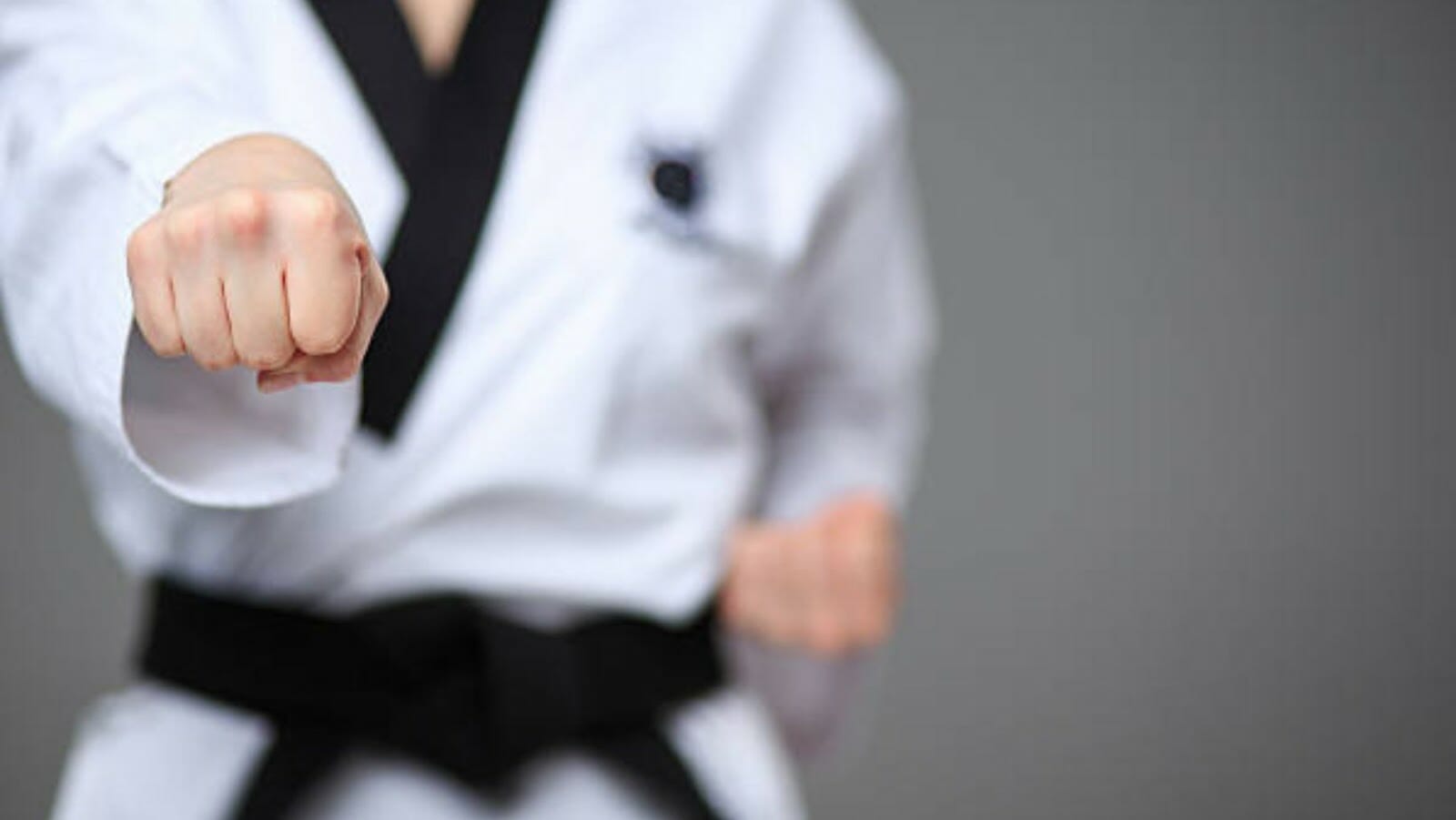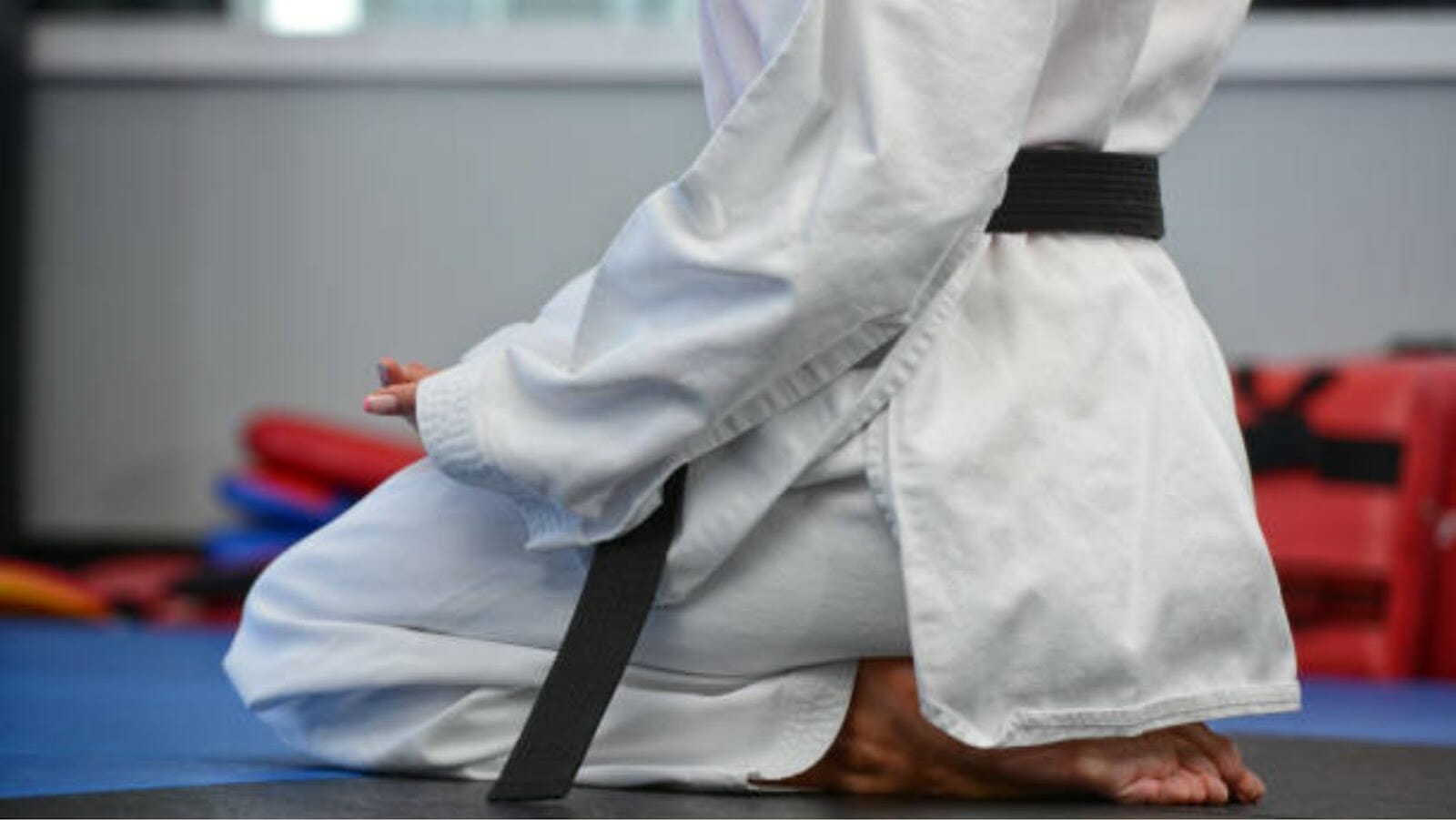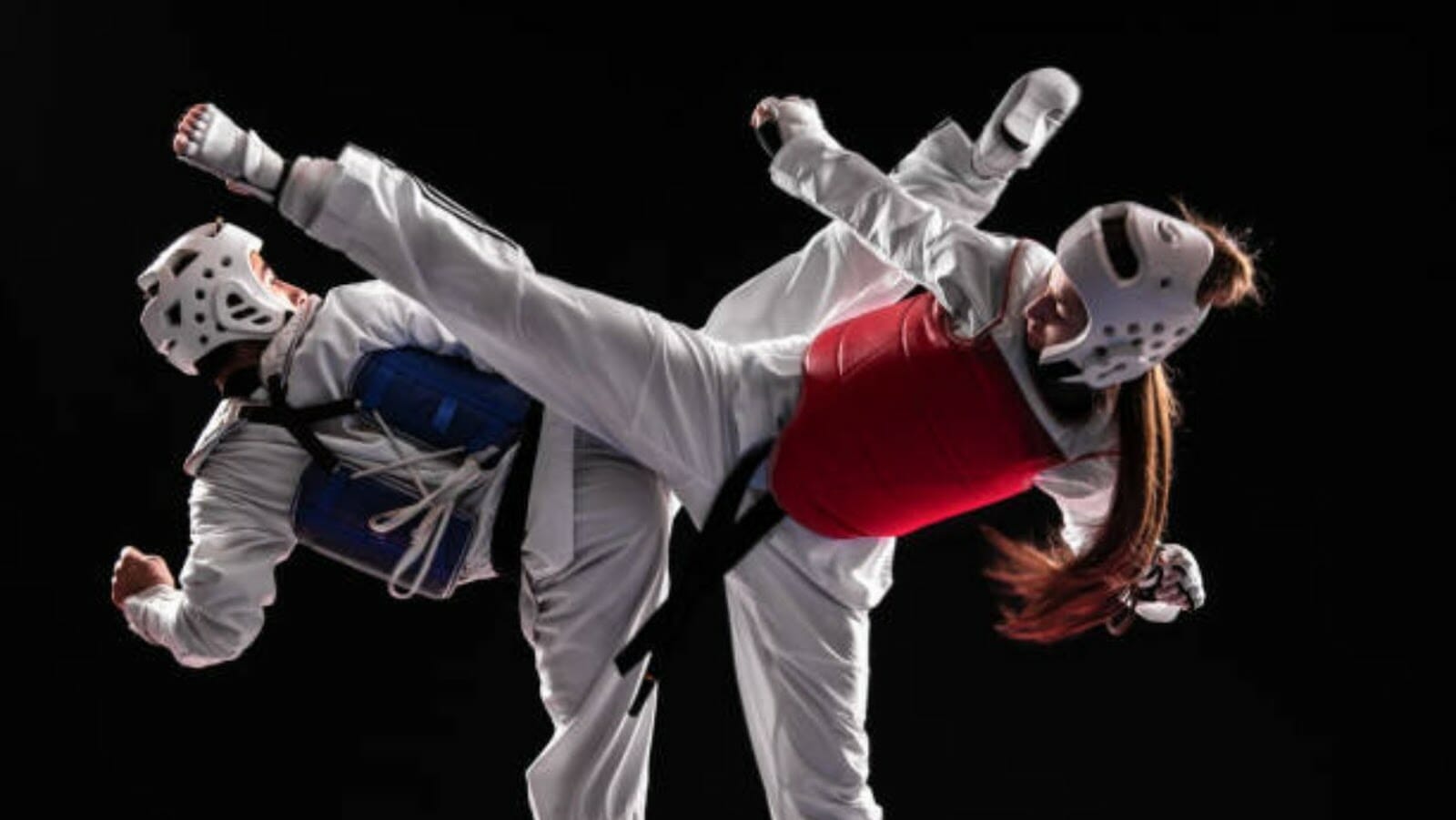Traditional Tae Kwon Do is a martial art that focuses on practical self-defense techniques that can be used in real-life situations. It includes various striking, kicking, and blocking designs that require speed, agility, and precision to master.
Here are some of the key techniques of traditional Tae Kwon Do:
StrikingKickingBlockingThrows and joint locks
Tae Kwon Do has a range of hand strikes, such as knife hands, ridge hands, punches, and palms, to strike opponents effectively. Tae Kwon Do has a variety of kicks, including front Kick, side kick, roundhouse kick, and back kick, that train your agility, balance, and timing. Tae Kwon Do emphasizes proper blocking techniques like the high, mid-block, and low blocks to defend against oncoming attacks. Tae Kwon Do also includes grappling techniques like throws and joint locks to take the opponent down and control them.
Pro Tip:
- Practice the basic techniques thoroughly.
- Understand their applications in different situations.
- Move on to more advanced techniques.
Basic Techniques
Traditional Tae Kwando is a martial art with a long history in the Korean peninsula. Its unique combination of physical and mental training has made it popular worldwide.
This article will explore the basic techniques used in traditional Tae Kwando and the benefits of mastering them.
Stances
Stances are the fundamental building blocks of traditional Tae Kwando techniques. During defensive and offensive maneuvers, these postures are used for balance, stability, and mobility. Some of the basic stances of traditional Tae Kwando are: StanceDescription Attention Stance Feet together, arms relaxed by the sides. Ready Stance Feet shoulder-width apart, toes pointed forward, arms raised in front of the body. Horse Stanc Feet shoulder-width apart, knees bent, back straight, arms held in front of the body. Front Stance One foot forward, knee bent, other foot behind and straight, body weight evenly distributed. Back Stance One foot back, knee bent, other foot forward and straight, body weight on the back foot. By mastering these stances, practitioners of traditional Tae Kwando can enhance their balance, strength, and agility, making them more effective in combat situations.
Punching Techniques
Punching is an essential technique in the practice of Traditional Tae Kwon Do. Here are some basic methods to improve your punching abilities:
1. Make a fist with your thumb wrapped around your fingertips.
2. Keep your wrist straight and your knuckles aligned with your wrist.
3. Use your whole body, not just your arm, to generate power.
4. Twist your hips and pivot your back foot as you punch to generate maximum power.
5. Aim for the target with the first two knuckles of your fist.
6. Focus on speed and accuracy, not just power.
7. Practice a variety of punches (jab, cross, hook, uppercut) to improve your technique and overall performance.
Remember to always warm up before practice and wear proper gear. You can improve your technique and become a skilled Tae Kwon Do practitioner with practice and dedication.
Kicking Techniques
Kicking techniques are integral to Tae Kwon Do, and mastering the basic techniques is essential to becoming proficient in this martial art. Here are the fundamental kicking techniques of traditional Tae Kwon Do:
Front Kick (Ap Chagi) – involves lifting the knee and extending the foot outward to strike the target in front.
Roundhouse Kick (Dollyo Chagi) – involves pivoting on the standing foot and kicking with the instep, heel, or ball of the foot in a horizontal circular motion.
Side Kick (Yop Chagi) – involves lifting the knee and extending the foot to the side in a straight line to strike the target.
Axe Kick (Naeryeo Chagi) – involves lifting the leg and slamming the heel down onto the target vertically from above.
Back Kick (Dwit Chagi) – involves returning to the opponent and kicking with the heel.
Combined with training and practice, these techniques can help develop the speed, agility, and accuracy necessary to excel in Tae Kwon Do.
soonho hong 805-3470006 ca 93454
Tae Kwando is one of the oldest martial arts still practiced today. It originated in Korea, and while it has evolved to become a more modern sport, it still has its roots in traditional self-defense techniques.
In this article, we will discuss the techniques of traditional Tae Kwando and how they can be used for self-defense.
Joint Locking Techniques
Joint locking techniques are integral to self-defense in traditional Tae Kwon Do, enabling you to immobilize your opponent and neutralize any potential threat.
Here are the most common joint locking techniques used in Tae Kwon Do:
TechniqueDescription
Wristlock This technique applies pressure to the wrist joint, forcing the opponent’s arm to bend in an unnatural direction.
Elbow lock This technique involves controlling the opponent’s elbow joint, limiting their range of motion and strength.
Shoulder lock This technique targets the shoulder joint, creating pain and discomfort while immobilizing your opponent.
Knee lock This technique involves creating leverage on the knee joint, forcing it to bend in a direction that causes pain and instability.
Combined with other Tae Kwon Do self-defense techniques, these joint locking techniques can help you defend yourself and stay safe in a dangerous situation.
Throwing Techniques
Throwing techniques are an essential component of traditional Tae Kwando self-defense techniques that require practice, accuracy, and speed to master.
Here are two common throwing techniques in Tae Kwando:
TechniqueDescription
Hip Throw In this technique, the attacker is thrown over the defender’s hip using their momentum. The defender uses their hip to lift the attacker, pulling them off balance.
Shoulder Throw This technique involves throwing the attacker over the defender’s shoulder. First, the defender grabs the attacker’s arm with one hand while sweeping their leg behind the attacker’s leg to unbalance them. The defender then throws the attacker over their shoulder and onto the ground.
These techniques require proper body mechanics, timing, and practice to execute effectively in a self-defense situation.
Pressure Point Techniques
Pressure point techniques are integral to traditional Tae Kwon Do, a martial art that focuses on striking techniques and self-defense.
Pressure points are areas of the body that are particularly vulnerable to strikes or pressure, and targeting these points can be an effective way to immobilize an opponent.
Here are a few pressure point techniques used in traditional Tae Kwon Do:
1. The wrist grab technique involves applying pressure to specific points on an opponent’s wrist to force them to release their grip.
2. The neck pressure technique targets the carotid artery in the neck, causing a temporary loss of consciousness or dizziness.
3. The temple strike targets the temple or side of the head and can cause disorientation or a knockout.
It is important to note that pressure point techniques should be used responsibly and cautiously, as they can cause serious injury or even death if not performed properly. Therefore, it is recommended to learn these techniques under the guidance of a trained martial arts instructor.
Sparring Techniques
Sparring is a fundamental part of traditional Tae Kwando, comprising different techniques and strategies. In this section, we will focus on conventional Tae Kwando sparring methods and talk about the basics of footwork, strikes, blocks, and counters.
Footwork
In traditional Tae Kwon Do, sparring techniques rely heavily on footwork for effective execution. Proper footwork allows practitioners to move quickly, maintain balance, and strike with power and precision.
Here are some essential footwork techniques in traditional Tae Kwon Do sparring:
TechniqueDescription
Step slide This technique involves stepping forward with one foot and sliding the other foot quickly to catch up, allowing the practitioner to maintain forward momentum without losing balance.
Pivot step In this technique, the practitioner pivots on the ball of one foot while stepping forward with the other foot, allowing for quick changes in direction and evasion of attacks.
Hop step This technique involves hopping forward on one foot and then quickly planting the other, allowing for explosive and sudden movements.
Backstep The backstep is used for retreating quickly, shifting weight to the back foot, and using it to push off for a quick backward movement.
By mastering these footwork techniques, traditional Tae Kwon Do practitioners can improve their sparring performance and become more effective martial artists.
Offensive Techniques
Offensive techniques are a crucial aspect of traditional Tae Kwon Do sparring. These techniques not only help you to score points but also enable you to defend yourself in a real-life situation. Here are some offensive techniques used in traditional Tae Kwon Do sparring: TechniqueDescription Front Kick A basic yet effective kick that targets the opponent’s stomach, chest, or chin. This technique involves raising your knee while keeping your foot flat and then kicking forward. Roundhouse Kick This technique targets the opponent’s ribs, thigh, or head. Start by lifting your knee and then pivot on the ball of your supporting foot to swing your leg in a horizontal arc. Back Kick This technique targets the opponent’s stomach or chest. Start by turning your back to the opponent and lifting your leg, then thrusting it back towards your opponent.
Side Kick This technique targets the opponent’s torso or head. Start by lifting your knee and pivoting on the ball of your supporting foot to kick your leg out to the side.
Mastering these techniques requires constant practice and dedication. Remember always to use them sensibly and for self-defense purposes only.
Pro tip: Study your opponent’s movements in sparring to find openings to execute these techniques effectively.
Defensive Techniques
Defensive techniques are an integral part of sparring in traditional Tae Kwando. These techniques help you avoid attacks and defend yourself against your opponent. Here are some of the defensive techniques used in conventional Tae Kwando:
TechniqueDescription
Blocks Blocking techniques involve using your arms or legs to deflect an opponent’s attack. Some popular blocking techniques include rising, outward, and inward blocks.
Evasions Evasive techniques are used to dodge an opponent’s attack, allowing you to move out of danger quickly. Examples include jumping evasions, side-stepping evasions, and front/back/side rolling evasions.
Parries Parrying techniques involve deflecting an opponent’s attack to create an opening for your counter-attack. Examples include low parries, mid parries, and high parries.
Interceptions Intercepting techniques are used to intercept an opponent’s attack before it gets too close. Examples include jumping interceptions, sliding interceptions, and standing interceptions.
These techniques can improve your sparring skills and help you defend yourself effectively.
isaimini 2022
In traditional Tae Kwando, forms or patterns are used to practice and master the different techniques. These forms are pre-arranged sequences of moves made up of kicks, blocks, and punches. By training with documents, you can increase your speed, agility, and balance while also getting familiar with the basic move sets of Tae Kwando.
Let’s discuss the different types of forms used in Tae Kwando.
Meaning and Purpose of Forms
Forms or patterns are a set of techniques used in Traditional Tae Kwando to emulate fighting scenarios, promote muscle memory and improve focus, balance, and coordination of movements. They are also known as Poomse or Hyung.
Forms showcase a sequence of offensive and defensive moves designed to simulate a fight. The techniques are executed with precision, rhythm, and fluidity, emphasizing breathing control and the movement of the body’s center of gravity.
Practicing forms help Tae Kwando practitioners improve their knowledge of the martial art, improve physical and mental stamina, and become more prepared for real-life fighting scenarios. Moreover, mastering forms require constant practice, concentration, and discipline, which helps students cultivate emotional and mental resilience.
Basic Forms or Patterns
Forms or Patterns are the foundation of techniques in Traditional Tae Kwando. These patterns are a set of movements performed in a sequence designed to promote balance, coordination, and overall understanding of Tae Kwando.
Here are the basic forms or patterns in Tae Kwando:
PatternDescription
Tae Geuk Il Jang This pattern consists of 18 movements and represents the symbol of heaven and the book.
Tae Geuk Yi Jang This pattern consists of 18 movements and symbolizes joyfulness and thunder.
Tae Geuk Sam Jang This pattern consists of 20 movements and symbolizes fire and the sun.
Tae Geuk Sa Jang This pattern consists of 20 movements and represents the symbol of wind and tree.
Tae Geuk O Jang This pattern consists of 20 movements and symbolizes the symbol of water and the lake.
Tae Geuk Yuk Jang This pattern consists of 23 movements and represents the symbol of the mountain.
Tae Geuk Chil Jang This pattern consists of 25 movements and represents the symbol of Keon.
These patterns help to enhance muscle memory and balance and improve overall Tae Kwando skills.
Advanced Forms or Patterns
Advanced forms or patterns are the techniques used in traditional Tae Kwando that involve a sequence of movements designed to simulate combat scenarios. These forms, known as promises in Korean martial arts, are used to develop muscle memory, flexibility, balance, and coordination.
Here are some tips to help you master advanced forms or patterns in Tae Kwando:
1. Focus on perfecting the basic techniques: Advanced forms build upon basic techniques such as punches, kicks, blocks, and strikes. Perfecting these techniques will make it easier for you to perform advanced forms.
2. Practice with a partner: Using a partner to help you practice can improve your timing, precision, and overall technique. You can also learn from each other’s mistakes and offer feedback.
3. Break down the form: Instead of trying to learn the entire state all at once, break it down into smaller sections and practice each until you master it. Then, gradually combine the `areas until you can complete the form.
With patience, dedication, and consistent practice, you can master advanced forms in Tae Kwando and improve your overall martial arts skills.
Weapon Techniques
Traditional Tae Kwando was developed on the Korean peninsula around the mid-1900s. It heavily relies on weapon techniques such as kicking, striking, and blocking to defend and attack. It was considered a way to hone in on physical and mental discipline as well as a way to build up strength.
This section will discuss the weapon techniques used in Traditional Tae Kwando.
Nunchaku Techniques
Nunchaku techniques are an integral part of traditional Tae Kwon Do weapon techniques.
TechniqueDescription
Figure Eight Hold the nunchaku at its midpoint and swing it in a figure-eight pattern. This technique can be used to block or strike your opponent.
Overhead Strike Hold the nunchaku with both hands and lift it over your head. Bring it down in a powerful strike aimed at your opponent’s head.
Forward Spin Hold the nunchaku at one end and spin it along, using your wrist to control the motion. This creates momentum and can be used to disarm your opponent.
Reverse Spin Hold the nunchaku at one end and spin it backward, using your wrist to control the motion. This technique can surprise your opponent and create an opening for an attack.
It’s important to practice these techniques with caution and respect for the dangerous nature of the nunchaku weapon.
Bo Staff Techniques
Bo staff techniques are an essential component of traditional Tae Kwon Do weapon techniques, involving using a long staff to defend oneself against attackers.
Here are some basic Bo Staff techniques:
TechniqueDescription
Middle Block Hold the Bo staff at its center, with one hand at each end, and execute a block in the middle.
Flip Hold the Bo staff horizontally on one end, flip it in a vertical plane, and catch it in the middle section.
Strike Hold the Bo staff with one hand at the bottom end and the other hand about two-thirds of the distance from the bottom of the team and execute a strike toward your opponent. Hold the Bo staff slightly above the center, and use the momentum to jab or thrust forward. These techniques require concentration, precision, and speed, and practicing them regularly can help martial artists master the art of Tae Kwon Do.
Sword Techniques
Sword techniques refer to the various methods and movements involved in the proper use of a sword as a weapon. Their fluid and precise movements often characterize these techniques and require discipline, focus, and practice to master.
Traditional Tae Kwondo includes various weapon techniques, including the use of swords. The methods of traditional Tae Kwondo emphasize the importance of proper balance, footwork, and coordination when handling a blade.
Some of the most commonly used sword techniques in traditional Tae Kwondo include cutting, thrusting, blocking, parrying, and footwork. Practitioners of conventional Tae Kwondo are encouraged to train with swords to develop a deeper connection with themselves and their craft and cultivate mental and physical discipline.











